Object Oriented JavaScript
- 1. Getting from Scripts to Applications Donald J. Sipe | Refresh Jacksonville | November 11 th 2008
- 2. JavaScript We are here Pseudoclassical Inheritance Hello World!
- 3. JavaScript What we’ll be talking about OOP Basics Scope Closures Context Appling to OOP Constructors Methods Public Private Privileged
- 4. But First... Some handy tools Here are some handy things you might not know JavaScript can do: Object-literal notation Anonymous functions Binary assignment Dot-style and array-style access of properties
- 5. Handy Tools Object Literal Notation— Makes JSON possible // The old way var myObject = new Object(); myObject.val = “test”; // Using object literal notation var myObject = { val: “test” };
- 6. Handy Tools Object Literal Notation // The old way var myArray = new Array(1, 30, “Refresh”); // Using object literal notation var myArray = [1, 30, “Refresh”];
- 7. Handy Tools Anonymous Functions In JavaScript, functions are treated as values, which means: Functions can be assigned to variables Functions can be passed as arguments to other functions
- 8. Handy Tools Anonymous Functions // Using an anonymous function as an argument setTimeout( function () { alert( “Refresh” ); }, 1000 ); // Using a function as a variable var myFunc = function () { alert( “Refresh” ); }; setTimeout(myFunc, 1000);
- 9. Handy Tools Anonymous Functions : Building a “scope bubble” Using an anonymous function to wrap code you don’t want in the global scope var globalVar = “Refresh”; // Global scope // Create a scope bubble ( function () { var privateVar = “Jacksonville”; alert( globalVar + “ ” + privateVar ); } )(); alert (privateVar == undefined );
- 10. Handy Tools Binary Assignment Set a default value only if the variable doesn’t have a value yet // Traditional ternary assignment var myVar = myVar ? myVar : 0; // Binary assignment var myVar = myVal || 0;
- 11. Handy Tools Dot-Style and Array-Style property access var sampleObj = { color: “blue”, width: “16px” }; // Traditional dot-style access alert( sampleObj.color == “blue” ); // Alternative array-style access alert( sampleObj[“width”] == “16px” );
- 12. Scope, Closures, and Context
- 13. Scope Only functions have scope. Blocks ( if , while , for , switch ) do not. All variables are within the global scope unless they are defined within a function . All global variables actually become properties of the window object When variables are not declared using the var keyword, they decared globally.
- 14. Scope var foo = “orig”; // foo is now a global variable if ( true ) { foo = “new”; // Global foo now equals “new” } // create function to modify its own foo variable function test () { var foo = “old”; } test(); alert( foo == “new” ); // Global foo still equals “new”
- 15. Scope If you forget to use the var keyword to define a value within a function—even if it’s only used within the function—the value will be defined globally. var foo = “new”; alert( foo == “new” ); // Omitting the var keyword reverts scope // of foo to global level function badTest () { foo = “bad news”; } badTest(); // Global foo now equals “bad news” alert( foo == “bad news” );
- 16. Scope: Inner Functions Functions can be defined within one another Inner functions have access to the outer function’s variables and parameters. function getRandomInt(max) { var randNum = Math.random() * max; function ceil() { return Math.ceil(randNum); } return ceil(); // Notice that no arguments are passed } // Alert random number between 1 and 5 alert(getRandomInt(5));
- 17. Closures Inner functions maintain the scope they enjoyed when their parent function was called—even after the parent function has terminated. This allows you to effectively pass variables to functions that may not be called for some time.
- 18. Closures function delayedAlert (message, delay) { // Set an enclosed callback setTimeout( function () { // Use message variable passed to outer function alert(message); }, delay); } // Display a message with a 5 second delay delayedAlert(“Refresh”, 5000);
- 19. Context Your code will always be running within the context of another object Context is maintained through the use of the this variable. function increment() { this .x = this .x || 0; return this .x++; }; alert( increment() == 0 ); alert( increment() == 1 );
- 20. Context var myObject = { set: function (newVal) { this .val = newVal; } }; alert( myObject.val == null ); // val property not set yet myObject.set(“Refresh”); alert( myObject.val == “Refresh” ); // val equals “Refresh” // Change the context of set() to the window object window.set = myObject.set; window.set( “Refresh Jacksonville” ); alert( myObject.val == “Refresh” ); alert( window.val == “Refresh Jacksonville” );
- 21. Context: Changing Contexts JavaScript provides two handy functions for executing a function within the context of another function: call( ) apply( )
- 22. Context: Changing Contexts Using call() — Arguments passed by name // Simple function to change the color style of a node function changeColor (newColor) { this .style.color = newColor; } // window.changeColor has no style property, so call fails changeColor( “red” ); // Grab the DOM node with the id “required” var reqField = document.getElementById( “required” ); // Call changeColor() within reqField’s context changeColor.call( reqField, “red” );
- 23. Context: Changing Contexts Using apply() — Arguments passed as an array // Simple function to change the color style of a node function changeColor (newColor) { this .style.color = newColor; } // Set the text color of the body element function setBodyTextColor () { changeColor.apply( document.body, arguments ); } setBodyTextColor( “black” );
- 25. Object Oriented Programming Now let’s apply all of this information to a more classical view of OOP in JavaScript: Constructors Object Methods Public Private Privileged
- 26. About Objects Almost everything written in JavaScript is an object Objects can be though of as a collection of properties—much like a hash in other languages JavaScript doesn’t have a concept of classes like other object-oriented languages Classes are simulated using a concept called prototypal inheritance
- 27. Constructors Like other languages, JavaScript uses the new operator to create new instances of objects. // Create User object constructor function User ( name ) { this .name = name; } // Create a new instance of a User var me = new User(“Bob”); // Alert new user’s name alert( me.name == “Bob” ); // Cannot call User directly alert( User.name == undefined ); // window.name is undefined
- 28. Methods
- 29. Public Methods One way to create a public method—a function that can be freely reference by code outside your object—is to attach it to the object’s prototype . An object’s prototype is a special property that acts as a base reference of your object. This prototype object is copied and applied to all new instances of your object.
- 30. Public Methods // Our User object written a different way var User = function (name) { this .name = name; } // Add a public accessor method for name User. prototype .getName = function () { return this .name; } var me = new User( “Bob” ); alert( me.getName() == “Bob” );
- 31. Private Methods Private methods are functions that are only accessible to methods inside your object and cannot be accessed by external code.
- 32. Private Methods // Our User object with some changes var User = function (name) { this .name = name; function welcome () { alert( “Welcome back, ” + this .name + “.”); } welcome(); } // Create a new User var me = new User( “Bob” ); // Alerts: “Welcome, Bob.” // Fails because welcome is not a public method me.welcome();
- 33. “ Privileged” Methods The term privileged method was coined by Douglas Crockford. It is not a formal construct, but rather a technique. Privileged methods essentially have one foot in the door: Then can access private methods and values within the object They are also publicly accessible
- 34. “ Privileged” Methods // Our User object with some tweaks var User = function (name, age) { var year = (new Date()).getFullYear() – age; this .getYearBorn = function () { return year; }; }; // Create a new User var me = new User( “Bob”, 28 ); // Access privileged method to access private year value alert( me.getYearBorn() == 1980 ); // Fails because year is private alert( me.year == null );
- 35. Grand Finale Using Scope , Closures , Contexts , and what we’ve discussed about OOP, we can dynamically generate classes based on information supplied to the constructor.
- 36. Grand Finale // Our User object modified to accept an object of properties function User (properties) { // Loop through properties and create getter and setter methods for ( var i in properties ) { function () { this [“get” + i] = function () { return properties[i]; }; this [“set” + i] = function (val) { properties[i] = val; }; })(); } } // Create a new user, automatically creating get and set methods var me = new User( { name: “Bob”, age: 28 });
- 37. Grand Finale // …continued // Note that name is private within properties alert( me.name == null ); // Access privileged getname() method alert( me.getname() == “Bob” ); // Use the dynamically generated setter // to change the user’s age me.setage(21); alert( me.getage() == 21 );
- 39. References Pro JavaScript Techniques, by John Resig Douglas Crockford’s YUI Theater Presentations http://developer.yahoo.com/yui/theater


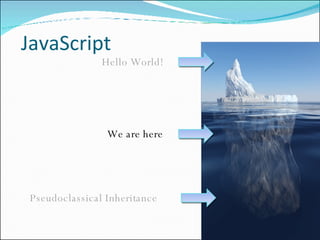

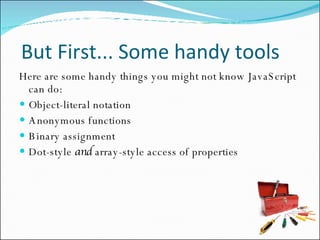
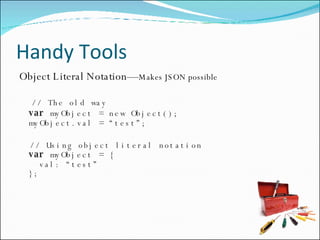
![Handy Tools Object Literal Notation // The old way var myArray = new Array(1, 30, “Refresh”); // Using object literal notation var myArray = [1, 30, “Refresh”];](https://image.slidesharecdn.com/objectoriented-javascript-1226850369553008-8/85/Object-Oriented-JavaScript-6-320.jpg)

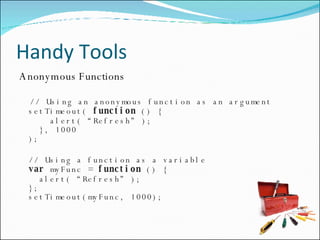

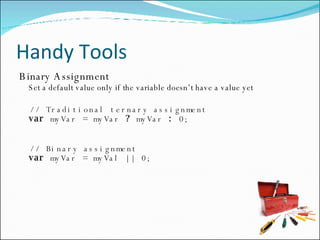
![Handy Tools Dot-Style and Array-Style property access var sampleObj = { color: “blue”, width: “16px” }; // Traditional dot-style access alert( sampleObj.color == “blue” ); // Alternative array-style access alert( sampleObj[“width”] == “16px” );](https://image.slidesharecdn.com/objectoriented-javascript-1226850369553008-8/85/Object-Oriented-JavaScript-11-320.jpg)

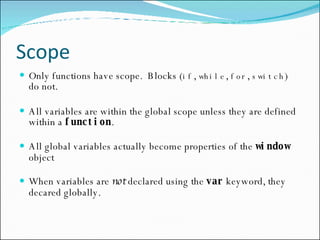












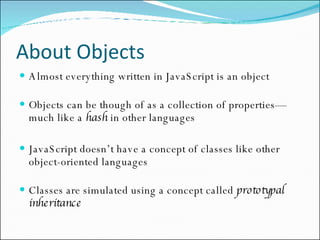









![Grand Finale // Our User object modified to accept an object of properties function User (properties) { // Loop through properties and create getter and setter methods for ( var i in properties ) { function () { this [“get” + i] = function () { return properties[i]; }; this [“set” + i] = function (val) { properties[i] = val; }; })(); } } // Create a new user, automatically creating get and set methods var me = new User( { name: “Bob”, age: 28 });](https://image.slidesharecdn.com/objectoriented-javascript-1226850369553008-8/85/Object-Oriented-JavaScript-36-320.jpg)


